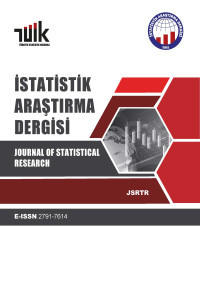Hipertansiyonun Tahmini için Çoklu Tahmin Modellerinin Karşılaştırılması
Bu çalışmada, kontrol ve hipertansiyonlu hasta grubunun tahmini için lojistik regresyon analizi (LR), flexible diskriminant analizi (FDA) ve neural networks (NNs) karşılaştırıldı. Aile hikayesi, lipoprotein A, trigliserid, sigara kullanımı ve vücut kitle indeksi tahminleyici değişken olarak ele alındı. Veriler, 2001 yılında Trakya Üniversitesi Tıp Fakültesi Kardiyoloji Kliniğinden elde edildi. Bütün modellerin ROC eğrisi altındaki alanları, 0.793-0.984 aralığında yer aldı. NNs 'nin duyarlılık, özgüllük ve doğruluk oranlan %90 'dan daha yüksek bulundu. NNs ve LR ile NNs ve FDA 'nın ROC eğrisi altında kalan alanları, istatistiksel olarak farklı bulundu (sırasıyla p<0.0005 ve p<0.0005). FDA ve LR'nin ROC eğrisi altında kalan alanları istatistiksel olarak farklı bulunmadı (p=O.394). NNs 'nin performansının LR ile FDA 'dan istatistiksel olarak daha iyi olduğuna karar verildi.
Anahtar Kelimeler:
Lojistik Regresyon Analizi, Neural Networks, Flexible Diskriminant Analizi, ROC Eğrisi
Comparison of Multiple Prediction Models for Hypertension
In this study, we compared logistic regression analysis (LR), flexible discriminant analysis (FDA) and neural networks (NNs) for predict of control and hypertension groups. Predictor variables were family history, lipoprotein A, triglyceride, smoking and body mass index. The data were collected from Cardiology Clinic of Trakya University Medical Faculty in Turkey, 2001. All models had areas under the receiver operating characteristic curve (ROC) in the 0.793-0.984 range. NNs had sensitivity, specificity, and accuracy greater than 90% at ideal threshold. ROC curve areas of NNs and LR, and NNs and FDA were statistically different (p<0.0005 and p<0.0005 respectively). ROC curve areas of FDA and LR were not statistically different (p=0.394). We concluded that performance of NNs was statistically better than LR and FDA.
___
- ABDUL-KAREEM, S., BABA, S. and ZUBAIRI Y.Z. (2001). Back Propagation Neural Network for· Medical Prognosis: A Comparison of Different Training Algorithms, Erişim:[http://www.sat.ait.ac.th/ejat/artcles/3.1/main.html ] .Erişim Tarihi: 20.03.2002
- CHEITLIN, M.D., SOKOLOW, M. and MCLLROY, M.B. (1993). Systemic Hypertension. Clinical Cardiology, Prentice-Hall Int. Inc., a Lange Medical Book.
- CRUICKSHANK, J.M., NEIL-DWYER, G., et al. (1989). Acute Effects of Smoking on Blood Pressure and Cerebral Blood Flow, J. Hum. Hypertens, 3: 443.
- DEMUTH, H., and BEALE, M. (2001). Neural Network Toolbox User's Guide, the Mathworks, Inc.: USA.
- ELFORD, J., PHILLIPS, A., et al. (1990). Migration and Geographic Variations in Blood Pressure in Britain, Br. Med. J., 300:291.
- FINE, T.L. (c1999). Feedforward Neural Network Methodology, Springer: New York.
- FOLKOW, R. (1993). The Pathophysiology of Hypertension. Differences Between Young and Elderly Patients, Drugs, 46 (suppl) 2:3-7.
- FRANCIS, L. (2001), the Basics of Neural Networks Demystified, Erişim: [http://www.contingencies.org/novdec01/workshop.pdf]. Erişim Tarihi: 9.01.2002
- HALL, W.D., WOLLAN, G.L. and TUTTLE, E.P. (1994). Diagnostic Evaluation of the Patient with Systemic Arterial Hypertension: an Overview, Hurst et al. (der.), the Heart. New York: McGraw-Hill Inc., 10.
- HASSOUN. M.H. (c1995). Fumdamentals of Artificial Neural Networks. Cambridge, Mass: MIT Press.
- HASTIE, T., TIBSHIRANI, R. and BUJA, A.(l995). Discriminant and Mixture Models, in Kay. J. & Titterington, D., (eds.) Neural Networks and Statistics. Oxford University Press.
- HASTIE, T., TIBSHIRANI, R. and BUJA, A.(1994). Flexible Discriminant Analysis by Optimal Scoring, Journal of The American Statistical Association 89: 1255-1270.
- HASTIE, T. and TIBSHIRANI, R. (1996). Discriminant analysis by Gaussian Mixtııres, Journal of the Royal Statistical Society (B), 58, 155-176.
- HAYKIN, S. (1999). Neural Network: A Comprehensive Foundation, Upper Saddle River, NJ: Prentice Hall.
- JO, I., AHN, Y., LEE, J., SHIN. K.R., et al. (2001). PreValance, Awareness, Treatmet Control and Risk Factors of Hypertension in Korea: the Ansan Study, Journal of Hypertension, 19 (9): 1523-1532.
- JOHNSON, RA., WICHERN, D.W. (1982). Applied Multivariate Statistical Analysis, PrenticeHall: New Jersey.
- KAPLAN, N.M. (1994). Clinical Hypertension. Baltimore, Williams and Wilkins.
- KIM, H. and LOH, W.-Y. (2002). Classification trees with bivariate linear discriminant node models, journal of Computational and Graphical Statistics, in press. (This paper extends CRUISE to fit linear discriminant models in terminal nodes.)
- LEE, H. K.H. (2000). Model Selection for Neural Network Classification, Erişim: [http://ftp.isds.duke.edu/WorkingPapers/00-18.pdf]. Erişim Tarihi: 02.04.2002
- ÖZDAMAR, K. (1999). Paket Programlar ile İstatistiksel Veri Analiz 1, Eskişehir, Kaan Kitabevi.
- ÖZDAMAR, K. (1999). Paket Programlar ile İstatistiksel Veri Analiz 2, Eskişehir, Kaan Kitabevi.
- SCHIEKEN, R.M. (1993). Genetic Factors that Predispoze the Child to Develop Hypertension, Pediatr Clin North Am., 40:1.
- SHARMA, S. (1996). Applied Multivariate Techniques, John Wiley&Sons: New York.
- SPERS, M.A.. KASL. S.V., et al. (1986). Blood Pressure Concordance Between Spouses, Am. J. Epidemiol.,123:818.
- TATLIDİL, H. (1996). Uygulamalı Çok Değişkenli İstatistiksel Analiz, Ankara, Akademi Matbaası.
- WILLIAMS, R.R., HUNT, S.C, et al. (1989). Current Knowledge Regarding the Genetics of Human Hypertension, J. Hypertens., 7(Suppl 6):8.
- WILLIAMS, R.R. (1989). Will Gene Markers Predict Hypertension?, Hypertension, 14:610.
- ISSN: 1303-6319
- Başlangıç: 2002
- Yayıncı: TÜİK
Sayıdaki Diğer Makaleler
Karmaşık Örnekleme Planlarında Çeşitli Varyans Tahmin Yöntemleri ve Uygulama
Sağdan Sansürlü Veriler için Parametrik Regresyon Modeli ve Kemik İliği Naklinde Kullanımı
Yüksel TERZİ, Yüksel BEK, Mehmet Ali CENGİZ
Ekstrem Değer Teorisi ile Riskin Değeri (Var)'ın Tahmini
Hipertansiyonun Tahmini için Çoklu Tahmin Modellerinin Karşılaştırılması
Mevlüt TÜRE, İmran KURT, Ebru YAVUZ, Turhan KÜRÜM
Rasgele Sıkıştırma Yoluyla Weibull Dağılımının Yeni Bir Karakterizasyonu
Sevgi YURT ÖNCEL, Fazıl ALİEV ALİOĞLU, Funda AYGÜN
Şehirleşme Seviyelerinin Projeksiyonu Üzerine Bir Araştırma
Türkiye'nin Sosyo-Ekonomik Yapısının Kanonik Korelasyon Analizi ile İncelenmesi
